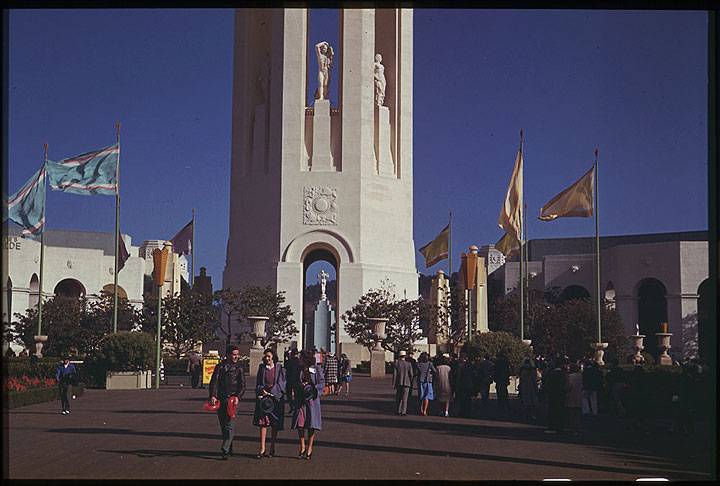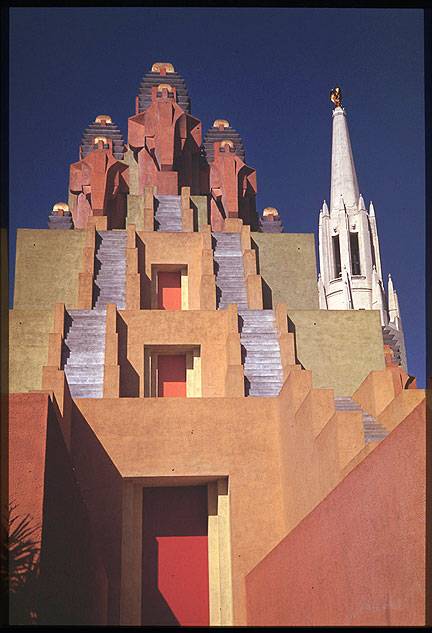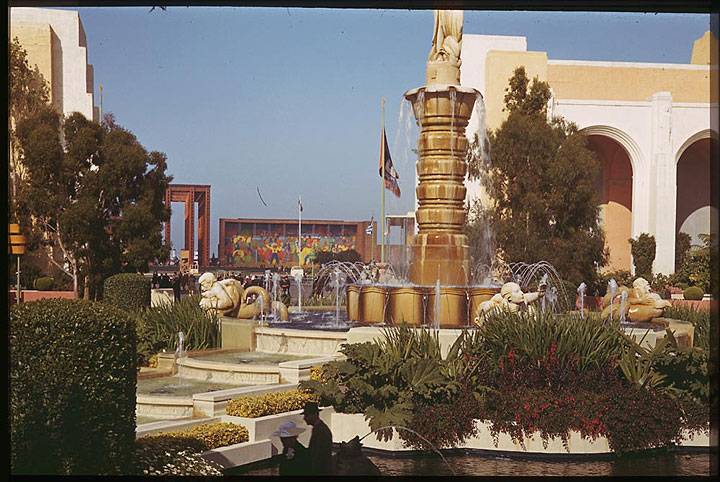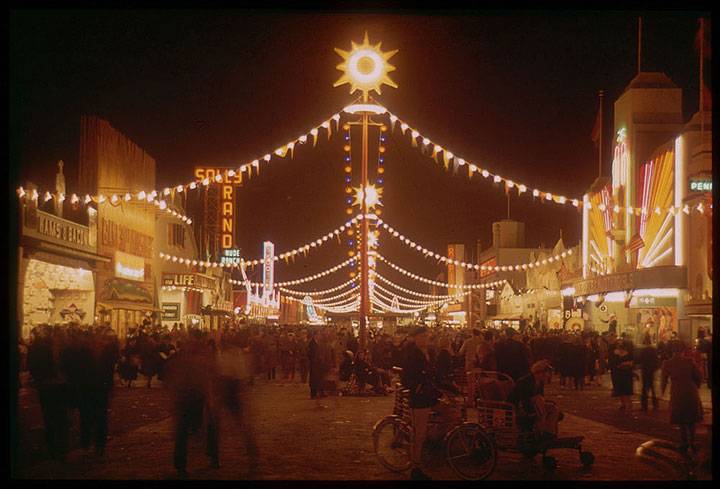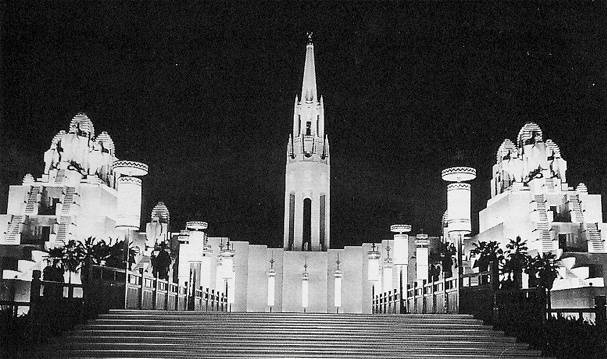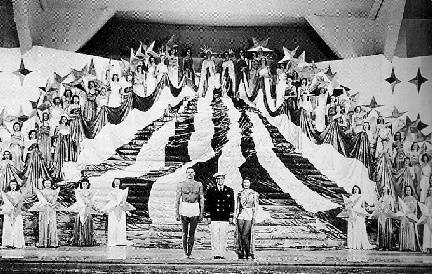Treasure Island Fair: Golden Gate International Exposition: Difference between revisions
No edit summary |
No edit summary |
||
| Line 85: | Line 85: | ||
[[The China Clipper |Prev. Document]] [[Connected Treasure Island Developers Cultivated Profitable Deal |Next Document]] | [[The China Clipper |Prev. Document]] [[Connected Treasure Island Developers Cultivated Profitable Deal |Next Document]] | ||
[[category:San Francisco outside the city]] [[category:1930s]] [[category:Amusement Parks]] [[category:Panorama]] | [[category:San Francisco outside the city]] [[category:1930s]] [[category:Amusement Parks]] [[category:Panorama]] [[category:Fairs]] | ||
Revision as of 16:49, 6 January 2011
Historical Essay
by Gail Hynes Shea
June 23, 1940, Sunday at the Golden Gate International Exposition on Treasure Island.
Charles Cushman Collection: Indiana University Archives (P01881)
“Romance, adventure, and the perfume of distant and exotic lands”
Over seventy years ago, a little bit of magic happened on Treasure Island. The Golden Gate International Exposition opened February 18, 1939 and ran until November, and opened again in 1940 from May through September. The Exposition was a tour de force of architecture, art, and dramatic lighting—all set on its own little island created on the shoals off Yerba Buena Island.
Viewed at night from the shores of San Francisco Bay, the Exposition was a floating, fairytale island of light. The monumental buildings were fantastically lit with indirect lighting. Multicolored spotlights shone their beams more than a mile up into the night sky. The Exposition was visible for more than 100 miles in every direction. It came to life for only two seasons and was nicknamed “The Magic City.”
{{#ev:archive|san_francisco_worlds_fair|640}}
News Parade newsreel footage of the San Francisco World's Fair in 1939, the Golden Gate International Exposition. The fair was intended to celebrate the opening of two bridges, the Golden Gate and the Bay Bridge. It was held on Treasure Island. 0551 PA8123 San Francisco World's Fair (The News Parade)
Video: Prelinger Archive
Elephant Towers at Treasure Island, June 23, 1940.
Charles Cushman Collection: Indiana University Archives (P01879)
The Golden Gate International Exposition was originally planned as a celebration of the recently completed Golden Gate and San Francisco-Oakland Bay bridges. As planning for the celebration progressed, organizers expanded the focus to encompass all the countries and continents surrounding the Pacific—with San Francisco as the gateway—and called it the Golden Gate International Exposition. Coming as it did during the Depression, the Exposition (as well as the two bridges) was a godsend to the state and local economy. Out-of-work architects, engineers, craftsmen and women, and artists were able to find work and expression in commissions for the Exposition.
The theme of the Exposition was “A Pageant of the Pacific,” emphasizing the unity, heritage and melding of cultures that share the Pacific Ocean. The eclectic blend of Oriental, Occidental, and South Pacific art and cultural symbolism emphasized harmony and unity. The Elephant Towers at the west entrance blended Oriental design and Mayan architecture. The Fountain of Western Waters in the Court of Pacifica featured sculptures representing Asia, North America, the Pacific Islands and South America at its compass points.
{{#ev:archive|GoldenGa1939_2|640}}
Amateur pictures, including aerials and color shot from ground level, of the San Francisco World's Fair on Treasure Island.
Video: Prelinger Archive
Charles Cushman Collection: Indiana University Archives (P01889)
Fourth of July celebration, Golden Gate International Exposition "Gayway".
Charles Cushman Collection: Indiana University Archives (P01915)
Arthur Brown, architect of the Tower of the Sun and the Court of Honor, wrote: “The surrounding Court of Honor and its accessories are planned to rhythmically amplify and become an integral part of the Tower [of the Sun] design.” This integration of open space, art, landscaping, architecture, color, light, and functionality was a hallmark of the Exposition.
During the second season of the Exposition, organizers began the Art in Action program. The Hall of Fine and Decorative Arts, which during the 1939 season had housed the art collections of European and Pacific cultures, in 1940 became a living, working art exhibit. Artists in many media—sculptors, painters, muralists, weavers, stained glass artists, printmakers, potters, engravers—were invited to move their studios into the Hall and create their art while the public watched. Artists included sculptor Ruth Cravath, mosaic artist Herman Volz, sculptor Dudley C. Carter, sculptor Frederick Law Olmsted, and etchings artist Elizabeth Ginno Winkler, among many others. Diego Rivera, the noted muralist, created a [fresco].
The Exposition closed forever on September 29, 1940. Originally scheduled to become the new San Francisco airport after the Exposition, Treasure Island was taken over by the U.S. Navy in support of the war effort. San Francisco was given land on the San Mateo County mudflats, where the airport still stands, as compensation for losing the Treasure Island facility. Some Exposition statuary and art was saved, others destroyed. A few artifacts remain scattered around the city and the country, but for the most part, the glory of the Exposition was abandoned for the practical requirements of war.
Gail Hynes Shea is an editor and writer in the San Francisco Bay Area. She is a fifth-generation Californian. This article originally appeared in Panorama, January–March, 2009 Vol. 21, No. 1, the newsletter of the San Francisco Museum and Historical Society.
Sources:
Original research by Anne Schnoebelen, member of the Treasure Island Museum Board of Directors, contributed significantly to this article.
The Architect and Engineer, February 1939
Treasures: Splendid Survivors of the Golden Gate International Exposition, by Anne Schnoebelen
Remains to be Seen: A descriptive catalog of surviving art and architecture of the Golden Gate International Exposition, by Anne Schnoebelen and Michael Gray
Treasure Island 1939 Fair; Main Tower.
Photo: Greg Gaar Collection, San Francisco, CA
1939 Treasure Island Fair performers.
Photo: Greg Gaar Collection, San Francisco, CA

